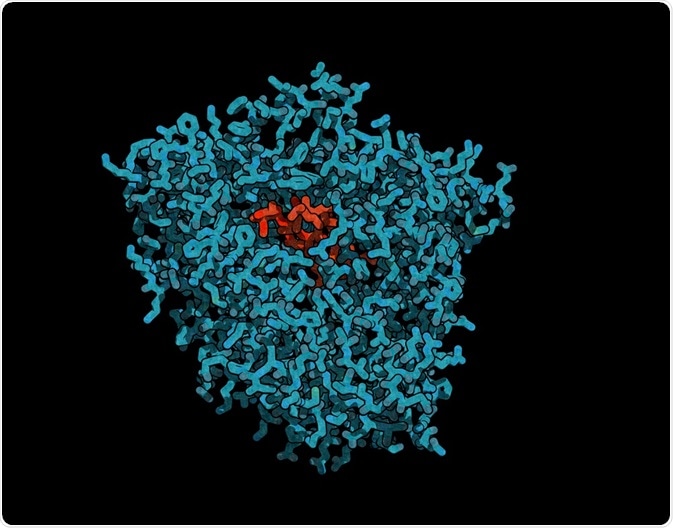Drugs are metabolized in the liver using several enzyme-catalyzed processes. These enzymes are collectively referred to as the hepatic microsomal enzyme system, and they are usually present in the endoplasmic reticulum of hepatocytes.
Skip to:
 Cytochrome P450 (CYP3A4) liver enzyme in complex with an antibiotic.
Cytochrome P450 (CYP3A4) liver enzyme in complex with an antibiotic.
Microsomal Enzymes
Microsomal enzymes are typically found in the endoplasmic reticulum of hepatocytes. Microsomes are fragments of endoplasmic reticulum and attached ribosomes that are isolated together when homogenized cells are centrifuged.
There are several microsomal enzymes, including flavin monooxygenases, cytochrome P450, NADPH cytochrome c reductase, UDP Glucoronosyl transferases (UGT), glutathione-S-transferases, epoxide hydrolases, etc. Cytochrome P450 and NADPH cytochrome c reductase are the two main enzymes in this system. Cytochrome P450 binds to oxygen, while the reductase shuttles electrons between NADPH to cytochrome P-450. This process is facilitated by phospholipids.
Cytochrome P450 Enzymes
The cytochrome P450 enzyme, also known as P450, belongs to a family of enzymes containing a heme complex that is non-covalently attached to a polypeptide chain or hemoproteins. The enzyme has been named as such because the hemoprotein can form a complex that maximally absorbs light of a wavelength of 450 nm. This enzyme is involved in metabolizing endogenous substances, such as in the synthesis of steroids, metabolism of retinoic and fatty acids, etc. Several of these enzymes are also present in humans, including CYP1A2, CYP2A6, and CYP4A11.
Induction of the hepatic microsomal enzyme system
The microsomal enzyme system can be activated by using an inducer drug that can bind to the receptor present in the cytoplasm or nucleus. This receptor-inducer complex then travels to the nucleus and forms a dimer. This heterodimer may bind to promoter regions of P450 genes, and increase gene expression. Some ligands that can induce the expression include omeprazole, phenobarbital, rifampicin, etc.
The induction of the enzyme system can increase the metabolic rate by two to four folds. This increase in the rate of enzyme production is maintained for as long as the inducer drug is present, and may return to its original values over a period of one to three weeks.
What happens to drugs once they have been metabolized?
Inducer drugs that are activated by metabolism in the liver act more intensively, possibly leading to drug toxicity. Whereas, drugs that are inactivated by metabolism may slow down and present lower intensity. Certain endogenous molecules, such as steroids and bilirubin may be metabolized further.
Inhibition of the enzyme system
The hepatic microsomal enzyme system can be inhibited by using drugs that act directly on the enzymes, reducing their efficacy. The process of inhibition may work by either competitive inhibition of drugs administered together, or by a process called suicide inhibition.
In the case of competitive inhibition, the drugs bind to P450 and competitively inhibit the metabolism of drugs administered together. In the case of suicide inhibition, the drug is metabolized by P450 and the reaction intermediate that is subsequently formed interacts with the heme moiety. This leads to inhibition of the metabolizing effect of P450.
Further Reading